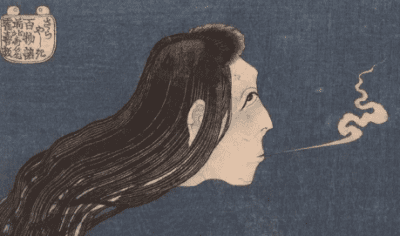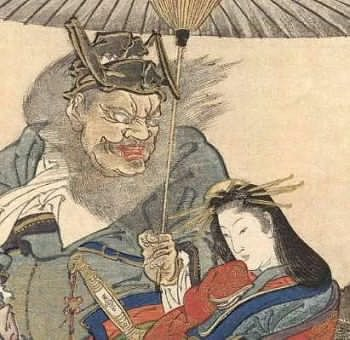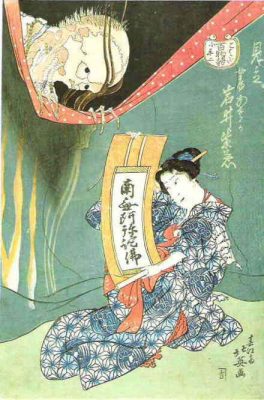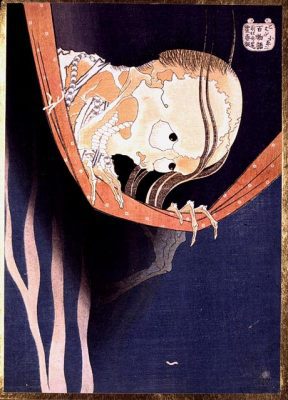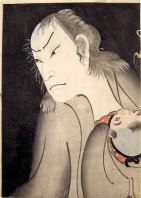Japanese Folklore and the Shinto Faith: Ghost Stories and Art
Lee Jay Walker
Modern Tokyo Times
Shintoism runs throughout the fabric of religion in Japan despite the powerful role of Buddhism within society. After all, Buddhism and other powerful influences including Confucianism emanate from outside this nation. Therefore, Shintoism influences folklore to various degrees throughout the ages of this nation.
Indeed, despite the enormous high-rise buildings of mega-cities including Nagoya, Osaka, and Tokyo, along with all the trappings of ultra-modernity in Japan, the old world survives even if pushed to the margins. This notably applies to Shinto religious festivals, aspects of Shintoism within animation including major films like Spirited Away and Mononoke, new business companies being blessed by a Shinto priest, literature, plays, and other realities related to small shrines that survive the ravages of modernity.
Not surprisingly, ghost stories and art depicts mysterious aspects of Shintoism that have been fused within mythology and the rich tapestry of Japanese folklore. Of course, major art themes emanating inside the rich diversity of ukiyo-e remain outside the world of Shintoism. Despite this, certain areas of Japanese culture and the mysterious underworld within the broad spectrum of ukiyo-e do depict themes that relate to Shintoism.
Another powerful reality related to Shintoism is the power of fusions that exist inside the body politic of Japanese Buddhism. Indeed, Buddhist temples and Shinto shrines sit naturally together within the landscape of Japan. Similarly, adorable Japanese gardens highlight the fusions of both faiths depending on the respective garden based on architecture, space, time, alignment, and other areas. In truth, the beauty of Shintoism is how it naturally relates to nature along with the openness of this faith to new ideas emanating inside the world of Buddhism and Confucianism.
In another article about a stunning art piece by Konishi Hirosada (Gosotei Hirosada) who depicts the ghost of Koheiji, I state he “…seeks revenge towards his wife Otowa and her devious lover because Koheiji is brutally tortured and murdered by Otowa, with the hands of her lover to blame within many realms of this story. The deeds of what happened are based on psychology and a very twisted crime of passion induced by strong emotions between both scheming individuals. Therefore, the absolute betrayal was brutally shocking and Koheiji now couldn’t enter the next world because his spirit was restless for revenge after being tortured.”
Amazing ghost stories like Koheiji and areas of mythology run deeply within art and modern themes like Japanese animation because of various elements within Shintoism that have inspired amazing creativity. In other words, the old world still exists despite the changing times of technology based on the intriguing nature of Shintoism and because of the flexibility of this faith. It may well be that Shintoism is now being marginalised in modern Japan. However, despite this reality, the faith exists within the shadows because of the rich cultural traditions of this country and the endless power of nature that flows naturally within the body politic of Shintoism.
http://www.toshidama-japanese-prints.com/item_261/Hirosada-The-Ghost-of-Togoros-Wife.htm
http://www.toshidama-japanese-prints.com/
http://toshidama.wordpress.com/
Modern Tokyo News is part of the Modern Tokyo Times group
DONATIONS to SUPPORT MODERN TOKYO TIMES – please pay PayPal and DONATE to sawakoart@gmail.com
http://moderntokyotimes.com Modern Tokyo Times – International News and Japan News
http://sawandjay.com Modern Tokyo Times – Fashion
https://moderntokyonews.com Modern Tokyo News – Tokyo News and International News
http://global-security-news.com Global Security News – Geopolitics and Terrorism
PLEASE JOIN ON TWITTER
https://twitter.com/MTT_News Modern Tokyo Times
PLEASE JOIN ON FACEBOOK
